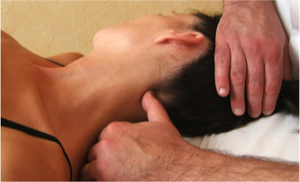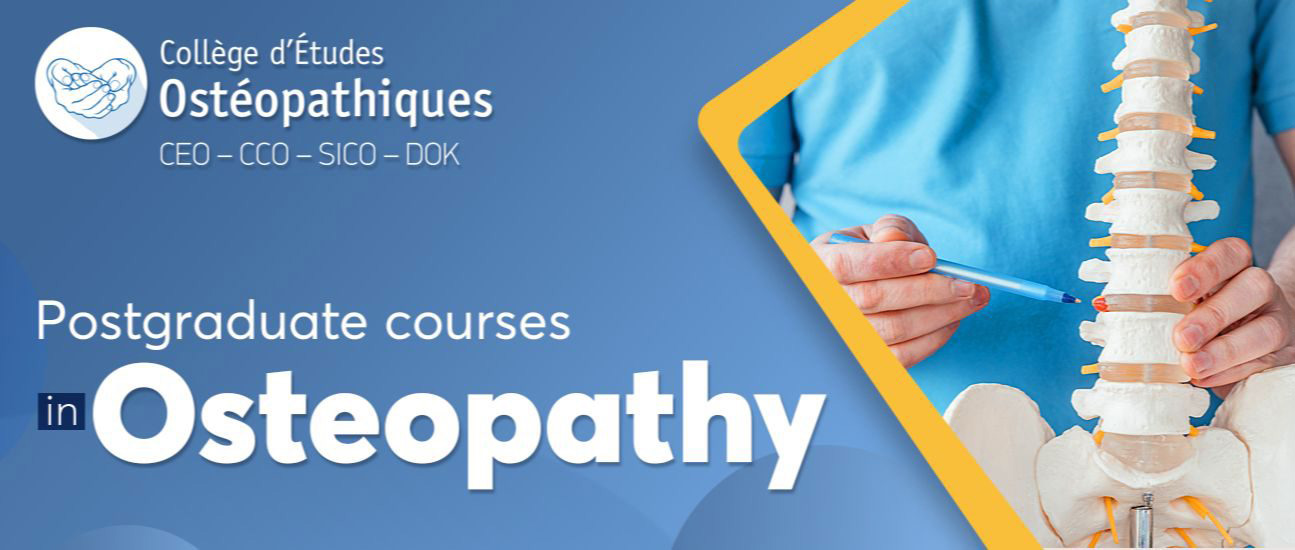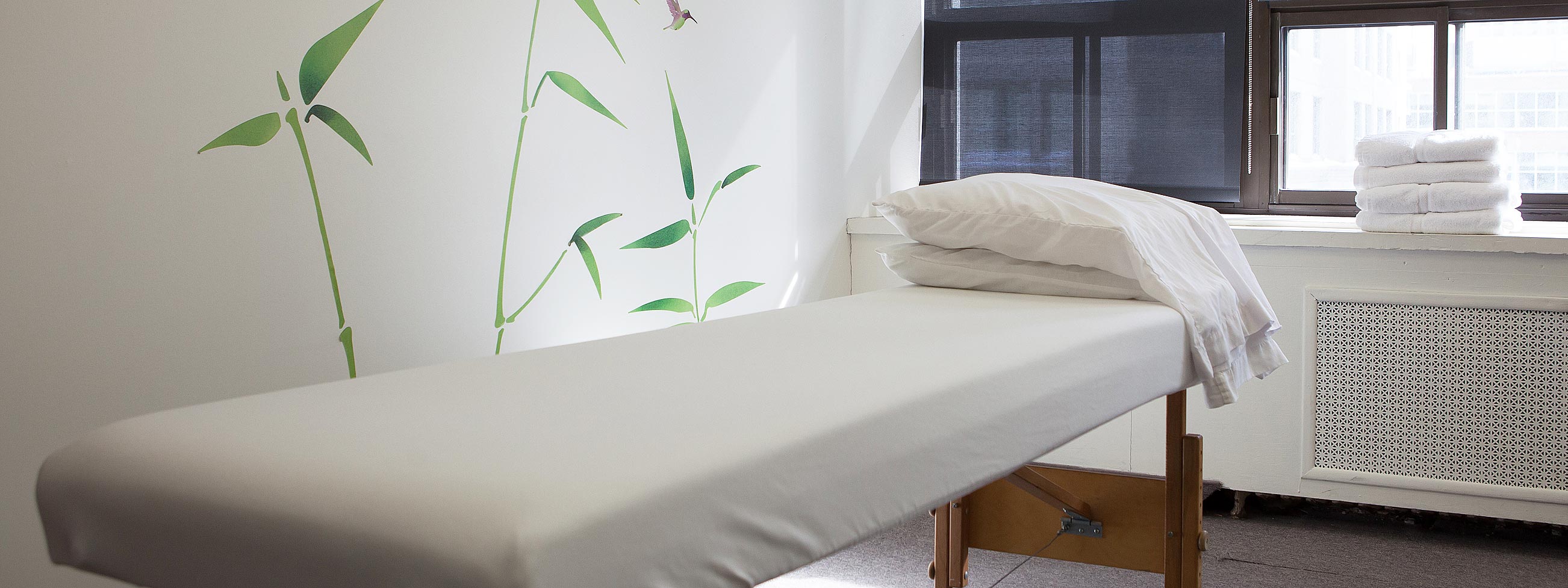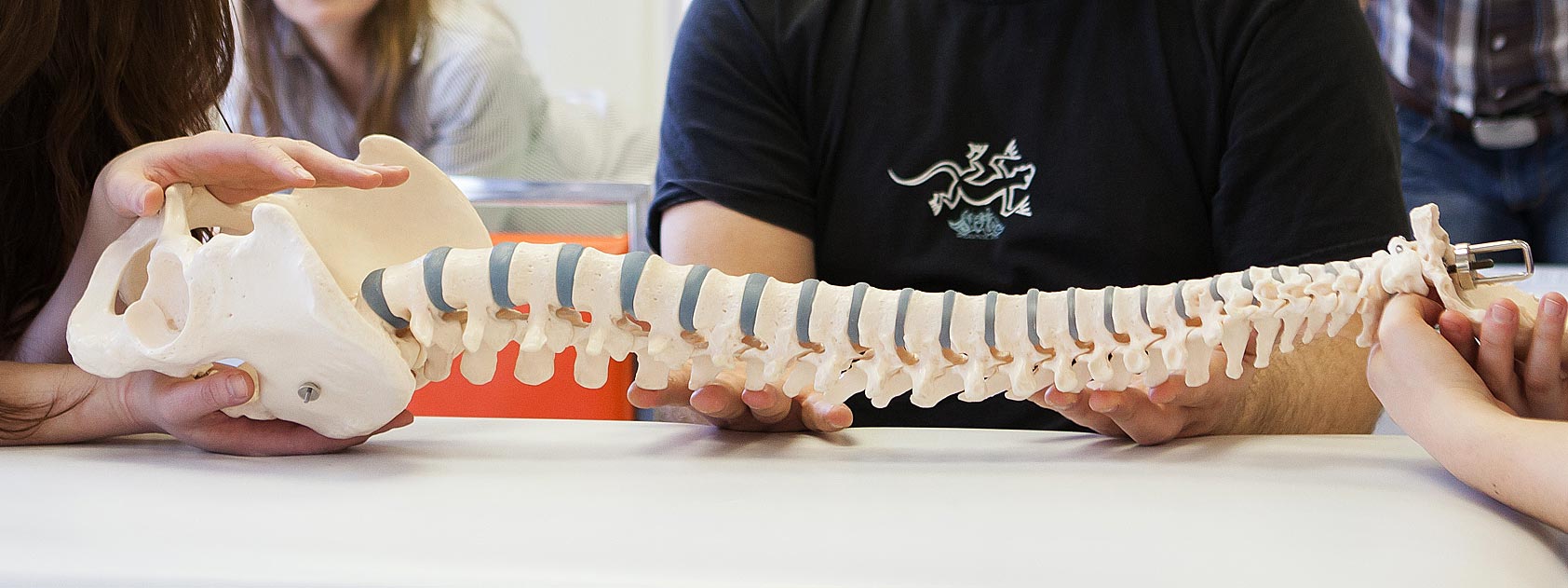Course series
Osteopathic Mechanical Link
The Osteopathic Mechanical Link is presented over a series of 6 courses.

Developed by Paul Chauffour D.O. and Eric Prat, D.O., the osteopathic mechanical link is an original approach designed to uncover and normalize the primary lesion, through the systematic examination of 8 functional units: the occipito-vertebro-pelvic axis, the thorax, the extremities, the intraosseous lines of forces and the articular diastases, the viscera and the organs, the arteries, the autonomic and peripheral nervous system, the cranium and the dermis.
Course descriptions (3 day courses)
LMO 1 — The LMO concept applied to the spine and thorax
Objective
This course presents the Osteopathic Mechanical Link methodology and its practical application to the vertebral axis, the thorax, and the upper and lower extremities.
The Osteopathic Mechanical Link concept rests on three key points:
Several new developments (filum terminale, segmental lesions of the sacrum, disc lesions, etc.) are presented in this course.
The posterior and anterior thorax is assessed using articular (costovertebral, chondrocostal and sternochondral joints, sternoclavicular joint) and intraosseous tests (sternebrae).
This is the reference course, mandatory and indispensable in order to take part in further courses.
The Osteopathic Mechanical Link concept rests on three key points:
- The tension tests which clearly show osteoarticular restrictions of elasticity, in a reliable and reproducible manner (*).
- The inhibitory balance tests that result in finding the dominant and secondary lesions.
- The recoil, for an adjustment without manipulation, using a simple, quick and efficient technique.
Several new developments (filum terminale, segmental lesions of the sacrum, disc lesions, etc.) are presented in this course.
The posterior and anterior thorax is assessed using articular (costovertebral, chondrocostal and sternochondral joints, sternoclavicular joint) and intraosseous tests (sternebrae).
This is the reference course, mandatory and indispensable in order to take part in further courses.
Program
Introduction to the concepts and techniques of the Osteopathic Mechanical Link (LMO).
The osteopathic lesion as a connective tissue scar with loss of tissue elasticity. Osteopathic lesion and somatic dysfunction. The total lesion and the 8 functional units. The dominant lesions and the primary lesion. The principle of prioritized treatment (which dictates where to begin and when to end an osteopathic treatment).
Finding anatomical structures using cutaneous depressions. Tissue tension diagnostic tests. Prioritization tests using the inhibitory balance. Adjustment technique using the recoil.
The osteopathic lesion as a connective tissue scar with loss of tissue elasticity. Osteopathic lesion and somatic dysfunction. The total lesion and the 8 functional units. The dominant lesions and the primary lesion. The principle of prioritized treatment (which dictates where to begin and when to end an osteopathic treatment).
Finding anatomical structures using cutaneous depressions. Tissue tension diagnostic tests. Prioritization tests using the inhibitory balance. Adjustment technique using the recoil.
- The occipitovertebropelvic axis. Basic tests, specific tests and treatment.
- The posterior and anterior thorax. Basic tests, specific tests and treatment.
(*) Reliabilitätsstudieüber die Befunderhebung der Wirbelsäulenach der Methode der Lien Mécanique Ostéopathique, Master ThesiszurErlangung des Grade “Master of Science”. Claudia Hafen-Bardella, Ostéopathe M Sc DO, Burgdorf, November 2009.
LMO 2 — The osteoarticular periphery
Objective
This course will present the practical application of the Osteopathic Mechanical Link to all joints and bones of the periphery with several interesting novelties.
The upper and lower extremities are examined using global tests to rapidly find the dominant articular lesion of the periphery.
All the articular lesions of the extremity to be normalised are then examined in an original manner with very detailed specific tests. The articular parameters of restriction are adjusted with precision using the recoil. The result on joint function (mobility) and pain is immediate.
Long bones are subject to fixations affecting the diaphysis (flexibility restriction) or the lines of force (compressibility restriction). In practice, in all chronic or complex cases, these different intraosseous osteopathic lesions are often dominant, and must therefore be normalised as a priority. Articular dysfunction is simply secondary, and therefore normalises spontaneously.
The articular diastasis is an unheeded osteopathic lesion that results in instability and hypermobility of the affected joints. Why do joint corrections by manipulation « not hold » ? The tests and adjustment technique proposed by the LMO identify and easily solve these problems of instability as well as their consequences (articular dysfunction, pain, repeated sprains).
The upper and lower extremities are examined using global tests to rapidly find the dominant articular lesion of the periphery.
All the articular lesions of the extremity to be normalised are then examined in an original manner with very detailed specific tests. The articular parameters of restriction are adjusted with precision using the recoil. The result on joint function (mobility) and pain is immediate.
Long bones are subject to fixations affecting the diaphysis (flexibility restriction) or the lines of force (compressibility restriction). In practice, in all chronic or complex cases, these different intraosseous osteopathic lesions are often dominant, and must therefore be normalised as a priority. Articular dysfunction is simply secondary, and therefore normalises spontaneously.
The articular diastasis is an unheeded osteopathic lesion that results in instability and hypermobility of the affected joints. Why do joint corrections by manipulation « not hold » ? The tests and adjustment technique proposed by the LMO identify and easily solve these problems of instability as well as their consequences (articular dysfunction, pain, repeated sprains).
Program
- The periphery. Basic tests of the upper extremity, the lower extremity and the pelvis.
- The peripheral articular lesion. Specific tests of all joints of the extremities (shoulder, elbow, wrist, hip, knee, ankle, etc.) and their normalisation.
- The intraosseous lesion of long bones. Specific tests of the diaphysis of the long bones of the periphery and their normalisation.
- The intraosseous line of force. Basic tests of the constraint lines of the peripheral skeleton and their normalisation.
- The osteopathic articular diastasis. Basic tests of the stability of peripheral joints and the spine and their normalisation.
LMO 3 — The osseous head
Objective
This course presents a completely new approach to the cranial sphere, which is not based on classical functional techniques but on a detailed analysis of the osteoarticular structure using tension tests on the key points of the osseous head. The examination is rapid, complete and precise. The hierarchy of lesions through inhibitory balance tests allows you to find the dominant lesion of the cranium. The normalisation of the different fixations of the osseous head by recoil is then simple and efficient.
The results achieved can be objectively ascertained not only through the Mechanical Link’s tension tests but also with classical listening tests: release the structure and function (the primary respiratory movement) will be re-established.
A course which will no doubt revolutionise your practice of cranial osteopathy…
The results achieved can be objectively ascertained not only through the Mechanical Link’s tension tests but also with classical listening tests: release the structure and function (the primary respiratory movement) will be re-established.
A course which will no doubt revolutionise your practice of cranial osteopathy…
Program
- The craniometric points. Finding the key points of the cranium.
- Architecture of the osseous head. Basic tests and normalisation of the different lines of force of the cranium : beams, pillars, arches, dome and keystone.
- The articular and membranous cranium. Basic tests and normalisation of the key points of the cranium: the 3 floors, the reciprocal tension membranes, the temporomandibular joint, the teeth, the bones of the face and the sinuses, the sutures of the vault and the sphenobasilar syndesmosis.
LMO 4 — The viscera
Objective
This course proposes a new, simple and efficient osteopathic approach to the visceral field.
The different viscero-organic structures are first located in an original manner using cutaneous depressions then systematically examined with basic tests.
The examination of the gynecological sphere is performed comfortably and simply, externally, with tests that have been validated in terms of efficiency by intra-vaginal ultrasound.
The dominant visceral osteopathic lesion is found using inhibitory balance tests and normalisation is performed by recoil.
The complete examination of the viscera and resulting normalisation are thus performed rapidly and efficiently within a few minutes.
A course that will give you the necessary and sufficient tools to approach this most important field of osteopathy with confidence.
The different viscero-organic structures are first located in an original manner using cutaneous depressions then systematically examined with basic tests.
The examination of the gynecological sphere is performed comfortably and simply, externally, with tests that have been validated in terms of efficiency by intra-vaginal ultrasound.
The dominant visceral osteopathic lesion is found using inhibitory balance tests and normalisation is performed by recoil.
The complete examination of the viscera and resulting normalisation are thus performed rapidly and efficiently within a few minutes.
A course that will give you the necessary and sufficient tools to approach this most important field of osteopathy with confidence.
Program
- The digestive tract. Basic tests and normalisation of the pharynx, the esophagus, the stomach, the gallbladder, the duodenum, the small and large intestine.
- The genitourinary organs. Basic tests and normalisation of the uterus, the ovaries, the prostate, the bladder and the kidney.
- The abdominal organs. Basic tests and normalisation of the spleen, the pancreas and the liver.
LMO 5 — The cardiovascular system
Objective
This course addresses a completely new field where the Mechanical Link has been a forerunner: the examination and osteopathic normalisation of the heart and the arteries.
Because arteries are constituted of connective tissue, they may present tissue fixations, the consequences of which are obviously disruptive to the body.
As the autonomic nervous system follows for the most part the vascular tree (vagus nerve, sympathetic chain, preaortic plexuses), the normalisation of the arteries is also key in a number of autonomic dysfunctions presented by patients.
How to test and normalise the cardiovascular system in osteopathy ?
This course will enable you to successfully apply in practice one of A.T. Still’s fundamental concepts: the rule of the artery!
Because arteries are constituted of connective tissue, they may present tissue fixations, the consequences of which are obviously disruptive to the body.
As the autonomic nervous system follows for the most part the vascular tree (vagus nerve, sympathetic chain, preaortic plexuses), the normalisation of the arteries is also key in a number of autonomic dysfunctions presented by patients.
How to test and normalise the cardiovascular system in osteopathy ?
This course will enable you to successfully apply in practice one of A.T. Still’s fundamental concepts: the rule of the artery!
Program
- The organs of the thoracic cavity. Basic tests and normalisation of the larynx, the trachea, the bronchi, the lungs and the heart.
- The arteries of the thorax. Basic tests and normalisation of the ascending aorta and the pulmonary arteries.
- The peripheral arteries. Basic tests and normalisation of the major arteries of the upper extremity and the lower extremity.
- The arteries of the abdomen. Basic tests and normalisation of the abdominal aorta (with the preaortic plexuses) and the iliac arteries.
- The arteries of the neck. Basic tests and normalisation of the brachiocephalic trunk, the subclavian arteries, the carotid arteries (with the vagus nerve and cervical sympathetic chain) and the vertebral arteries.
LMO 6 — The nervous system
Objective
How to integrate the peripheral nerves in your general osteoapthic examination easily and rapidly ?
During this course, we will see that the major nerve pathways accessible to palpation may be easily assessed (test) and normalised (recoil) using selected and well referenced key points.
Using the indisputable reference model that is anatomy, the correspondence established between key points of the nervous sytem and the major points of acupuncture also opens fascinating perspectives.
The numerous and important therapeutic applications (acute or chronic pain, autonomic disorders, immunity, stress, sleep, etc.) are validated by more than twelve years of clinical experience.
This course is uniquely illustrated by anatomical dissections and illustrations realised by the teaching team.
A reference course which constitutes a true hyphen between osteoapthy and acupuncture.
During this course, we will see that the major nerve pathways accessible to palpation may be easily assessed (test) and normalised (recoil) using selected and well referenced key points.
Using the indisputable reference model that is anatomy, the correspondence established between key points of the nervous sytem and the major points of acupuncture also opens fascinating perspectives.
The numerous and important therapeutic applications (acute or chronic pain, autonomic disorders, immunity, stress, sleep, etc.) are validated by more than twelve years of clinical experience.
This course is uniquely illustrated by anatomical dissections and illustrations realised by the teaching team.
A reference course which constitutes a true hyphen between osteoapthy and acupuncture.
Program
- The key points of the cranial nerves. Basic tests and normalisation of the trigeminal, facial, vagus and accessory nerves.
- The key points of the cervical nerves. Basic tests and normalisation of the posterior branches of the cervical nerves, the superficial cervical plexus, the phrenic nerve and the brachial plexus.
- The key points of the nerves of the upper extremity. Basic tests and normalisation of the radial, median and ulnar nerves.
- The key points of the lumbar plexus. Basic tests and normalisation of the iliohypogastric, ilioinguinal, lateral femoral cutaneous, obturator, femoral and saphenous nerves.
- The key points of the sciatic nerve. Basic tests and normalisation of the tibial and fibular nerves.







